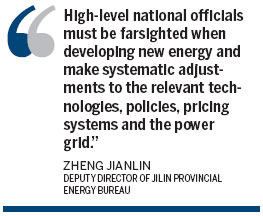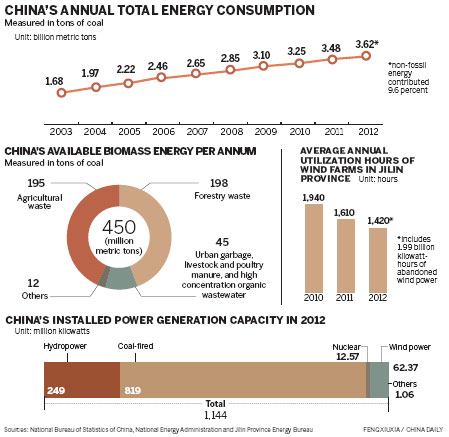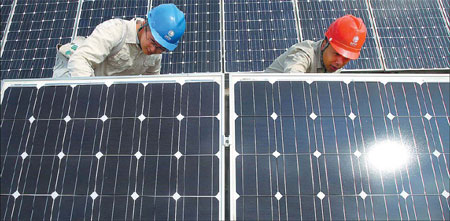Solution to growth of new-energy firms blowing in the wind
Updated: 2013-09-18 07:49
By Jiang Xueqing (China Daily)
|
||||||||
Green development is facing a series of obstacles, as Jiang Xueqing reports in Changchun.
Seven years after China's Renewable Energy Law took effect in January 2006, renewable energy companies are making huge contributions to the reduction of air pollution.
The act was introduced with the aim of promoting the use of non-fossil fuel energy. However, the companies, which include wind farms and biomass energy plants, are also suffering huge financial losses.
From January to July, Huaneng Taobei Wind Farm in Baicheng, Jilin province, generated 134.75 million kilowatt-hours of wind power. During the same period, it lost 72.48 million kWh of unused wind power, resulting in a loss of almost 40 million yuan ($6.5 million).
The wind farm's average annual utilization hours, the time during which it is running at full capacity, reached just 1,425 hours in 2012, but its break-even figure is about 1,560 hours.
During the first half of 2013, the farm averaged 813 utilization hours - the lowest in the country - and it is likely to continue to lose money, chief engineer Zhang Weilong says.
The farm's owner, China Huaneng Group, is debating whether to begin construction of the fourth phase. The previous three phases cost between 1.3 and 1.4 billion yuan.

Chen Xin, manager of the wind farm's pre-project department, speaking at a media event, said, "We'd rather put the project on hold, as the more wind turbines we build, the more money we lose."
The company's losses were caused by an oversupply of electricity in Jilin. Although the province had a total installed power capacity of 26 million kilowatts in 2012, the maximum demand for power was just 8.6 million kw.
'Curtailing' power
In winter, especially after midnight from January to March when the wind blows most strongly, wind turbines are shut down to ensure that the power already generated by combined heat and power generators will be used to provide sufficient heat for residential, industrial and commercial use, a process known as "curtailing power".
"Several years ago, when the provincial government officials were making plans for the development of heating measures during winter, they didn't leave any room for the growth of new energy," said Zheng Jianlin, deputy director of the Jilin provincial energy bureau.
Jilin province's installed power capacity doubled in the period 2006 to 2010, from roughly 10 million kw to more than 20 million. During that period, the local government encouraged State-owned enterprises to build a large number of thermal power plants in the province to boost the growth of gross domestic product, but failed to take the provincial demand for electricity into account. It will take three to five years to adjust the discrepancy between supply and demand, said Zheng.
One solution would be to use long-distance transmission lines to deliver surplus wind power from the west of Jilin, where wind resources are rich, to regions where energy consumption is high.
The central government has permitted preparatory work for construction of several 500,000 kw conversion stations in cities such as Baicheng and Songyuan, but the project is still awaiting official approval.
"We earnestly hope that the central government will help us build an extra-high-voltage transmission line to carry power from Jilin to North and East China," said Zheng.
Compared with the power grid, wind power projects have a much faster examination and approval procedure and a shorter construction period. That means the development of the power grid has been unable to keep pace with the growth of wind farms.
To ensure that construction and operation are in step, wind farm developers have increased preliminary communications with power grid companies regarding their plans for wind energy projects.
"In the past, China's power grid was designed to serve conventional energy resources such as coal, but in the future, it should be changed to serve new energy," said Zheng. "High-level national officials must be farsighted when developing new energy and make systematic adjustments to the relevant technologies, policies, pricing systems and the power grid."
In addition to transmitting wind-generated power to other regions, Jilin is also trying to increase its own electricity consumption by using curtailed wind power for heating. Datang Xiangyang Wind Power Generation Co is currently testing a heating station in Taonan in northwestern Jilin.
The station replaced one coal-fired boiler, which had a generating capacity of 20 metric tons of steam an hour, with nine electric thermal storage heaters, which consumed 27 million kilowatt-hours of curtailed wind power during a five-month heating season, a move that saved 8,000 tons of coal and reduced carbon dioxide emissions by 35,000 tons.
Price anomaly
Despite significant environmental benefits, the station lost 10 to 20 million yuan every year because the residential heating price in Taonan remained at around 27 yuan per sq m, while the cost of generating heat using electricity was much higher, said Zhang Xuezheng, Party secretary of Datang Xiangyang Wind Power Generation Co.
Moreover, the company had to generate heat with electricity purchased from the State Grid Corp at an average price of more than 0.5 yuan per kWh, almost the same as the post-tax price of the company's on-grid wind power.
"The government compensated our company by allowing us to produce more electricity, so the profits from the generation of wind power just about covered the losses we incurred from supplying heat," said Zhang.
He said that only when the government breaks the constraints on the prices of electricity and heating, will renewable energy companies be willing to fully develop public interest projects, such as the use of curtailed wind power to replace coal-fired heating.
Subsidy stalemate
Biomass power plants are also plagued by high costs and low prices. In 2012, the Jilin Gongzhuling biomass project generated more than 200 million kWh of electricity but only made a tiny profit of 0.0133 yuan per kWh. Fuel costs accounted for about 70 percent of the on-grid price for electricity generated from biomass, or 0.75 yuan per kWh, including a benchmark electricity price of 0.41 yuan and a subsidy of 0.34 yuan.

The Ministry of Finance was also tardy with subsidy payments to National Gongzhuling Bio Energy Co Ltd, the project's main investor. National Gongzhuling did not receive the monthly subsidies for 2012 until January this year and is still awaiting the money for April to June. The situation has forced the company to rely on working capital loans to pay local farmers to collect straw, said Du Jiang, deputy general manager of the company.
Because of the oversupply of electricity in Jilin, the Gongzhuling biomass project cut power generation by 13 million kWh between January and July, causing a decline in revenues of 9.75 million yuan.
According to the Renewable Energy Law, power grid enterprises should buy all the grid-connected power generated through renewable energy within the range of their power grids. In practice, however, none of the provincial governments has enforced the law strictly enough, said Zheng from the Jilin provincial energy bureau.
"We don't need government subsidies or policies, but we do want effective enforcement of the renewable energy law," said Zhang of Datang Xiangyang Wind Power Generation Co.
"Given that the law has proved difficult to implement, the National Development and Reform Commission should launch a policy to specify the proportion of power generated with renewable energy - let's say 10 percent of China's total electricity consumption - as soon as possible. In this way, renewable energy will still have plenty of room for further development," said Zheng.
Contact the writer at jiangxueqing@chinadaily.com.cn
Wu Wencong and Zhao Xu also contributed to this story.

|
A wind farm at Rudong in Jiangsu province. China's installed wind power capacity had reached almost 63 million kilowatts by the end of 2012. Xu Congjun / for China Daily |
|
Men unload bark at the National Gongzhuling Bio Energy Co in Jilin, which has developed a biomass project. Jiang Xueqing / China Daily |
|
Workers from a power grid company check a solar power facility installed on the roof of a residence in the city of Nantong in Jiangsu province. Xu Congjun / for China Daily |

(China Daily USA 09/18/2013 page8)

 Shipwrecked Concordia lift upright
Shipwrecked Concordia lift upright
 All's fare as apps take road to upgrades
All's fare as apps take road to upgrades
 New-energy vehicle policy shifts gears
New-energy vehicle policy shifts gears
 Thirteen dead in US Navy Yard shooting
Thirteen dead in US Navy Yard shooting
 'Amazing Shanghai' on display in Big Apple
'Amazing Shanghai' on display in Big Apple
 Exporters to face more trade friction
Exporters to face more trade friction
 Watchdog bites with no favor
Watchdog bites with no favor
 Shipwrecked Concordia declared vertical off Italy
Shipwrecked Concordia declared vertical off Italy
Most Viewed
Editor's Picks

|

|

|

|

|

|
Today's Top News
Trending news across China on Sept 18
China supports US-Russia deal on Syria
EU ready for talks with China on investment pact
Fine-particle pollution climbs in August: report
Number of China's female billionaires on the rise
Gun control debate gathers little steam
Don't meddle in HK's affairs, China warns UK
Education elusive for children with disabilities
US Weekly

|

|









